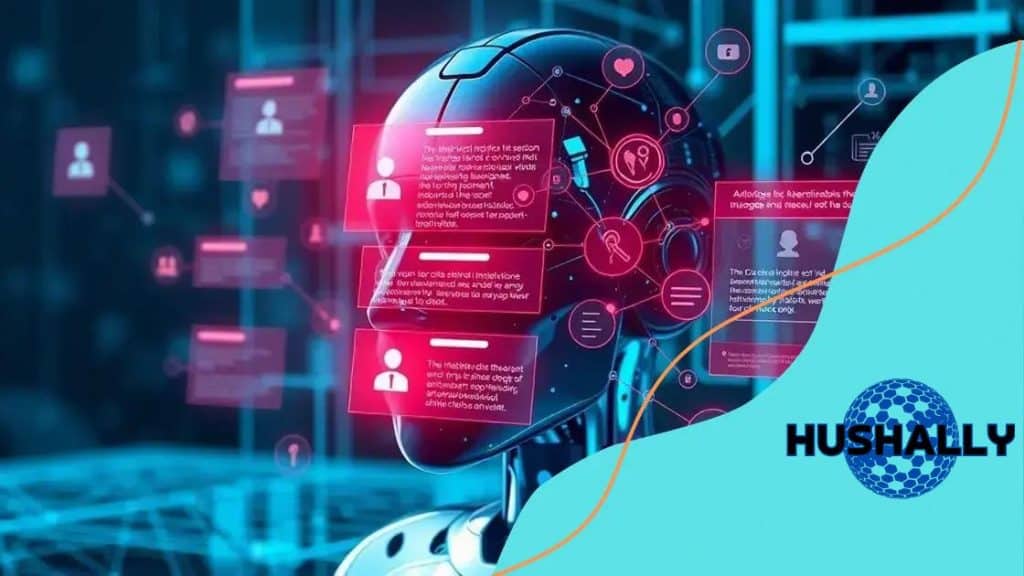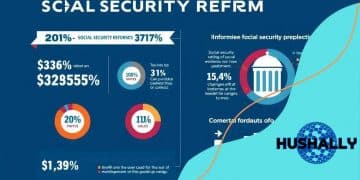AI combating online misinformation: a new frontier

AI combating online misinformation uses advanced algorithms to detect and flag misleading content, enhancing information accuracy across social media and news platforms.
AI combating online misinformation is becoming essential as false narratives spread. Have you ever wondered how AI technologies can help us identify what is true? Let’s explore this fascinating world together.
Understanding the impact of online misinformation
Understanding the impact of online misinformation is crucial in today’s digital age. Every day, countless pieces of information circulate online, but not all of it is true. Online misinformation can shape opinions and influence behavior, often leading to confusion and distrust.
To grasp its effects fully, let’s dive into how misinformation spreads and its broader implications.
How Misleading Information Spreads
Misinformation can travel faster than facts. It often begins with a single post that gains traction, leading others to share it. Here are some factors that contribute to its spread:
- Emotional engagement: Content that evokes strong emotions tends to be shared more frequently.
- Social media algorithms: Platforms prioritize engaging content, often amplifying sensationalized information.
- Lack of fact-checking: Many users share information without verifying its accuracy.
- Confirmation bias: People are more likely to believe and share information that aligns with their existing beliefs.
Understanding how this misinformation spreads helps us recognize the signs and avoid falling victim to it. It’s more than just social media posts; it can influence politics, health decisions, and even personal relationships.
Consequences of Misinformation
The consequences of online misinformation can be severe. Misinformed individuals may make poor decisions based on false information, leading to public health scares or widespread panic during crises. Moreover, misinformation can erode trust in legitimate news sources, making it harder for people to differentiate between fact and fiction.
As misinformation continues to evolve, so must our understanding of its impact on society. Fostering critical thinking and encouraging healthy skepticism are essential. When we recognize the importance of verifying information, we contribute to a more informed public.
Moreover, the development of advanced technologies plays a significant role in addressing this issue. Artificial Intelligence (AI) is now being employed to detect and combat misinformation. By analyzing patterns and flagging unverified content, AI can help guide users toward credible information.
In sum, understanding the impact of online misinformation is key to navigating today’s crowded information landscape. By being vigilant and proactive, we can help reduce its harmful effects.
How AI detects fake news
How AI detects fake news is a fascinating topic. Artificial Intelligence (AI) plays a vital role in identifying false information online. By using complex algorithms and vast data sets, AI can analyze patterns in news articles and social media posts to flag potential misinformation.
One major technique AI uses is called natural language processing (NLP). This allows AI to understand the context and meaning of words. By analyzing text, AI can determine whether the information is credible or likely false.
Techniques Used by AI
There are several techniques AI employs to detect fake news effectively. Some of these methods include:
- Sentiment analysis: This helps identify the emotional tone of the text, revealing if it’s meant to provoke outrage.
- Source verification: AI checks the credibility of the source by cross-referencing it with reliable databases.
- Content comparison: AI compares current articles against verified information to spot discrepancies.
- Image recognition: AI analyzes accompanying images to check if they have been manipulated or taken out of context.
These methods provide a comprehensive approach to discerning fact from fiction. As AI technology advances, its ability to detect fake news is becoming more sophisticated.
Another significant aspect is the use of machine learning. This involves training AI models on large datasets containing both factual and false information. Over time, these models learn to recognize characteristics of deceitful content, improving their accuracy.
It’s not just social media that benefits from these advancements. News outlets can also use AI to ensure their reporting is based on verified facts. By embracing these technologies, both journalists and audiences can be more informed, reducing the spread of fake news.
As we continue to explore how AI detects misinformation, it becomes clear that this technology is crucial in promoting a more truthful online environment.
Real-world examples of AI in action

Real-world examples of AI in action showcase how this technology is combating online misinformation effectively. Companies and organizations are using AI to address the spread of false information across various platforms.
One notable example is the use of AI by social media platforms to detect fake news. These platforms employ algorithms that analyze user-generated content in real-time. By identifying patterns in posts that are often flagged as misleading, AI helps to prevent the dissemination of false narratives.
Examples of AI Implementation
Several organizations are at the forefront of using AI to fight misinformation. Here are a few examples:
- Facebook: Facebook uses AI tools that automatically flag questionable content for further review. By leveraging machine learning, the platform can learn from previous instances of misinformation.
- Google: Google employs AI in its fact-checking tools, which provide users with context and verified information alongside search results. This helps users discern the credibility of the information they encounter.
- Twitter: Twitter actively uses algorithms to identify and label tweets that may be misleading. These warnings help users approach controversial topics with more caution.
- Fact-checking websites: Numerous fact-checking organizations utilize AI to scan and analyze news articles and social media posts, quickly determining their validity.
These implementations illustrate the varied ways AI is applied to enhance information accuracy. As AI continues to evolve, its methods for tackling misinformation will also become more refined.
Additionally, AI assists journalists by providing insights into trending misinformation. By analyzing social media data, AI highlights emerging false claims, allowing reporters to investigate and debunk them swiftly. This collaboration between technology and journalism promotes a healthier information ecosystem.
In educational settings, AI is increasingly being used to teach critical thinking skills, helping students analyze information sources effectively. By fostering awareness about misinformation, we can empower individuals to engage with content more thoughtfully.
The role of social media platforms
The role of social media platforms is crucial in the fight against online misinformation. These platforms are where false information often spreads rapidly, influencing public opinion and behavior. Understanding their role can help us see how they address and manage this issue.
Social media companies are increasingly aware of their impact and responsibility. They implement various measures to combat misinformation. For example, they utilize advanced algorithms and artificial intelligence to identify and flag suspicious content quickly.
Methods Used by Social Media Platforms
Here are some methods that social media platforms use to combat misinformation:
- Fact-checking partnerships: Many platforms collaborate with independent fact-checking organizations. These partnerships help verify the accuracy of information shared by users.
- Content moderation: AI and human moderators review reported posts. They decide if content violates community guidelines or if it requires a warning label.
- User education: Social media platforms often run campaigns to educate users about recognizing misinformation. These campaigns teach critical evaluation skills.
- Limiting reach: When misinformation is flagged, platforms may reduce the visibility of such content to minimize its spread.
These measures contribute significantly to creating a safer online environment. However, challenges remain. Misleading information can disguise itself as credible, making detection difficult. Additionally, users may disregard warnings or fact-checks.
Social media platforms continue to innovate to stay ahead of new tactics used by those spreading misinformation. Frequent updates to algorithms and increased transparency about how content is handled help build trust with users. By fostering an informed user base, these platforms aim to mitigate the effects of false information.
Ultimately, the role of social media is vital in addressing the challenges posed by misinformation. By implementing effective strategies, they can help promote a more informed society.
Future implications of AI combating misinformation
The future implications of AI combating misinformation are significant as technology continues to evolve. We are already seeing how advancements in AI can change the way we consume and share information online. As these technologies improve, their ability to detect and combat fake news will also enhance.
One major implication is increased accuracy in identifying misinformation. AI systems will become more adept at analyzing context and nuance in language, making them better at spotting misleading claims that may not be obvious at first glance.
Potential Developments
As AI technology develops, we can expect several important shifts:
- Enhanced monitoring: AI will enable continuous monitoring of content shared across platforms, identifying misinformation in real-time.
- More intelligent algorithms: Future algorithms could leverage deeper learning methodologies to improve understanding of complex narratives and tackling misinformation.
- Integration with user tools: AI could also be integrated into users’ tools, like browsers and social media apps, providing alerts when they encounter potentially fake news.
- Personalized fact-checking: Users may receive tailored fact-checking services based on their browsing habits and the content they encounter online.
Furthermore, the collaboration between AI and human oversight will likely grow stronger. While AI can process vast amounts of data quickly, human insight will remain essential for evaluating nuanced information and context.
As misinformation tactics change, AI will need to adapt accordingly. Developing systems that not only detect misinformation but also educate users about their findings will be key. This could lead to a more informed society that can engage critically with the content they consume.
Ultimately, the role of AI in combating misinformation is set to expand, offering new tools for detection, prevention, and education. By embracing these technologies, society can move towards a future where accurate information prevails.
FAQ – Frequently Asked Questions about AI Combating Misinformation
How does AI help detect fake news?
AI analyzes patterns in articles and social media posts to quickly identify and flag potentially misleading content.
What role do social media platforms play in this fight?
Social media platforms use AI to monitor content, verify sources, and reduce the reach of posts flagged as misinformation.
Can AI educate users about misinformation?
Yes, AI can be integrated into browsers and apps to provide alerts and educational resources when users encounter questionable content.
What is the future of AI in combating misinformation?
The future includes more sophisticated algorithms, personalized fact-checking, and stronger partnerships between AI and human oversight.





